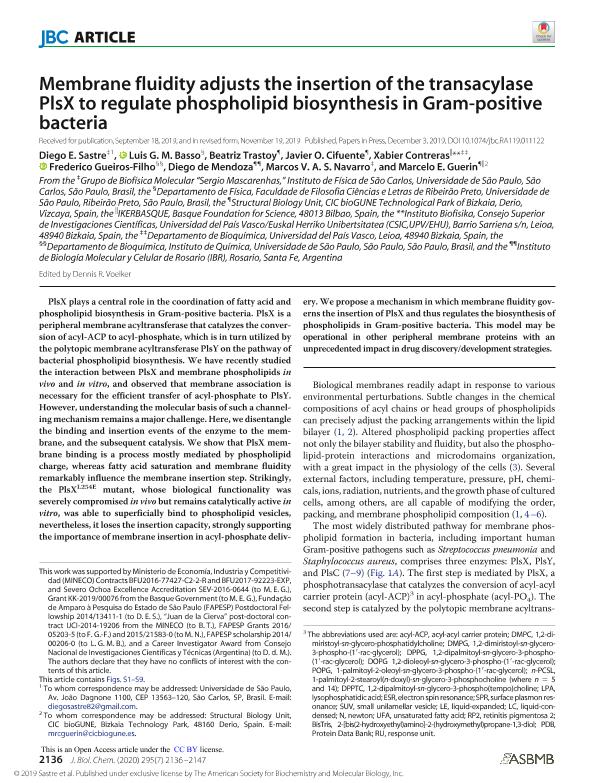Mostrar el registro sencillo del ítem
dc.contributor.author
Sastre, Diego Emiliano

dc.contributor.author
Basso, Luis G. M.
dc.contributor.author
Trastoy, Beatriz Alicia

dc.contributor.author
Cifuente, Javier Orlando

dc.contributor.author
Contreras, Xabier
dc.contributor.author
Gueiros Filho, Frederico
dc.contributor.author
de Mendoza, Diego

dc.contributor.author
Navarro, Marcos V. A. S.
dc.contributor.author
Guerin, Marcelo E.
dc.date.available
2023-01-26T15:04:29Z
dc.date.issued
2020-02
dc.identifier.citation
Sastre, Diego Emiliano; Basso, Luis G. M.; Trastoy, Beatriz Alicia; Cifuente, Javier Orlando; Contreras, Xabier; et al.; Membrane fluidity adjusts the insertion of the transacylase PlsX to regulate phospholipid biosynthesis in Gram-positive bacteria; American Society for Biochemistry and Molecular Biology; Journal of Biological Chemistry (online); 295; 7; 2-2020; 2136-2147
dc.identifier.issn
0021-9258
dc.identifier.uri
http://hdl.handle.net/11336/185780
dc.description.abstract
PlsX plays a central role in the coordination of fatty acid and phospholipid biosynthesis in Gram-positive bacteria. PlsX is a peripheral membrane acyltransferase that catalyzes the conversion of acyl-ACP to acyl-phosphate, which is in turn utilized by the polytopic membrane acyltransferase PlsY on the pathway of bacterial phospholipid biosynthesis. We have recently studied the interaction between PlsX and membrane phospholipids in vivo and in vitro, and observed that membrane association is necessary for the efficient transfer of acyl-phosphate to PlsY. However, understanding the molecular basis of such a channeling mechanism remains a major challenge. Here, we disentangle the binding and insertion events of the enzyme to the membrane, and the subsequent catalysis. We show that PlsX membrane binding is a process mostly mediated by phospholipid charge, whereas fatty acid saturation and membrane fluidity remarkably influence the membrane insertion step. Strikingly, the PlsXL254E mutant, whose biological functionality was severely compromised in vivo but remains catalytically active in vitro, was able to superficially bind to phospholipid vesicles, nevertheless, it loses the insertion capacity, strongly supporting the importance of membrane insertion in acyl-phosphate delivery. We propose a mechanism in which membrane fluidity governs the insertion of PlsX and thus regulates the biosynthesis of phospholipids in Gram-positive bacteria. This model may be operational in other peripheral membrane proteins with an unprecedented impact in drug discovery/development strategies.
dc.format
application/pdf
dc.language.iso
eng
dc.publisher
American Society for Biochemistry and Molecular Biology

dc.rights
info:eu-repo/semantics/openAccess
dc.rights.uri
https://creativecommons.org/licenses/by/2.5/ar/
dc.subject
PHOSPHOLIPID BIOSYNTHESIS
dc.subject
MEMBRANE BINDING
dc.subject
MEMBRANE INSERTION
dc.subject
MEMBRANE FLUIDITY
dc.subject
PROTEIN-LIPID INTERACTION
dc.subject
GRAM-POSITIVE BACTERIA
dc.subject.classification
Biofísica

dc.subject.classification
Ciencias Biológicas

dc.subject.classification
CIENCIAS NATURALES Y EXACTAS

dc.subject.classification
Bioquímica y Biología Molecular

dc.subject.classification
Ciencias Biológicas

dc.subject.classification
CIENCIAS NATURALES Y EXACTAS

dc.title
Membrane fluidity adjusts the insertion of the transacylase PlsX to regulate phospholipid biosynthesis in Gram-positive bacteria
dc.type
info:eu-repo/semantics/article
dc.type
info:ar-repo/semantics/artículo
dc.type
info:eu-repo/semantics/publishedVersion
dc.date.updated
2021-09-06T21:05:04Z
dc.journal.volume
295
dc.journal.number
7
dc.journal.pagination
2136-2147
dc.journal.pais
Estados Unidos

dc.description.fil
Fil: Sastre, Diego Emiliano. Consejo Nacional de Investigaciones Científicas y Técnicas; Argentina
dc.description.fil
Fil: Basso, Luis G. M.. Universidade de Sao Paulo; Brasil
dc.description.fil
Fil: Trastoy, Beatriz Alicia. No especifíca;
dc.description.fil
Fil: Cifuente, Javier Orlando. Consejo Nacional de Investigaciones Científicas y Técnicas; Argentina
dc.description.fil
Fil: Contreras, Xabier. Universidad del País Vasco; España
dc.description.fil
Fil: Gueiros Filho, Frederico. Universidade de Sao Paulo; Brasil
dc.description.fil
Fil: de Mendoza, Diego. Consejo Nacional de Investigaciones Científicas y Técnicas. Centro Científico Tecnológico Conicet - Rosario. Instituto de Biología Molecular y Celular de Rosario. Universidad Nacional de Rosario. Facultad de Ciencias Bioquímicas y Farmacéuticas. Instituto de Biología Molecular y Celular de Rosario; Argentina
dc.description.fil
Fil: Navarro, Marcos V. A. S.. Universidade de Sao Paulo; Brasil
dc.description.fil
Fil: Guerin, Marcelo E.. No especifíca;
dc.journal.title
Journal of Biological Chemistry (online)

dc.relation.alternativeid
info:eu-repo/semantics/altIdentifier/url/http://www.jbc.org/lookup/doi/10.1074/jbc.RA119.011122
dc.relation.alternativeid
info:eu-repo/semantics/altIdentifier/doi/http://dx.doi.org/10.1074/jbc.RA119.011122
Archivos asociados
